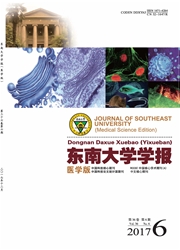

 中文摘要:
中文摘要:
目的:探讨近红外荧光分子标记的凝集素样氧化低密度脂蛋白受体-1(LOX-1)抗体探针在ApoE-/-鼠主脉动脉粥样硬化近红外荧光(NIRF)成像中的可行性。方法:将ApoE-/-小鼠以高脂饮食喂养20周,建立动脉粥样硬化模型。将24只ApoE-/-动脉粥样硬化模型小鼠随机分为3组,即抗LOX-1抗体-NIR-797组、非特异性IgG—NIR-797组和单纯磷酸盐缓冲液(PBS)组,每组8只,分别经尾静脉注入抗LOX-1抗体-NIR-797、非特异性IgG-NIR-797和单纯PBS。另取8只C57BL/6小鼠作为对照组,经尾静脉注入抗LOX-1抗体-NIR-797,注入探针24h后取小鼠主动脉及主要脏器行NIRF成像,再取主动脉行油红O染色,比较NIRF成像面积和油红O染色面积比例的差异。结果:ApoE-/-小鼠经尾静脉注入抗LOX-1抗体-NIR-797探针24h后,NIRF成像显示有强荧光信号聚集于小鼠离体主动脉的斑块区域,而注入非特异性IgG—NIR-797组斑块区信号明显减弱,PBS组及对照组C57BL/6小鼠仅见较弱荧光信号,单因素方差分析结果显示差异有统计学意义(F=232,P〈0.001)。NIRF阳性面积与斑块油红O染色面积比例分别为(42.70±1.25)%和(42.78±1.51)%,两者差异无统计学意义(t=0.409,P=0.695)。结论:近红外荧光分子标记的抗LOX-1抗体探针能够特异性地显示ApoE-/-鼠主动脉粥样硬化斑块的分布,可以作为小鼠动脉粥样硬化斑块成像的有效工具,LOX-1将来可能成为-个新的评价动脉粥样硬化的良好靶点。
 英文摘要:
英文摘要:
Objective: To explore the role of near-infrared fluorescence (NIRF) probes NIR-797 targeted anti-LOX- 1 antibodies in atherosclerotic lesions imaging in aortic atherosclerosis lesions of ApoE deficient mice. Methods:Apolipoprotein E -/- (ApoE -/- ) mice were fed with high cholesterol diet for 20 weeks to establish atherosclerotic model. Twenty-four ApoE -/- mice were randomly divided into 3 groups(8 in each group) and injected with anti- LOX- 1- Ab- NIR- 797, IgG- NIR- 797 and phosphate buffered saline (PBS) respectively. Eight wild- type C57BL/6 mice were injected with anti-LOX-1-Ab-NIR-797 as control group. NIRF imaging of the aortas and major organs were performed 24 hours after tail vein injection of probes, followed by aortic excision for oil red O staining. Reults: NIRF imaging showed significant fluorochrome enhancement accumulation in atherosclerotic plaques in ApoE -/-mice with the anti-LOX-1-Ab-NIR-797 probe but not enough with the nonspecific IgG probe. Little signal enhancement was observed in ApoE-/- mice injected with the PBS and Wild-type C57BL/6 mice injected with anti-LOX-1-Ab-NIR- 797 probe. The percentage of positive areas in imaging of NIRF and oil red O staining 24 h after injection of NIR-797 labeled anti- LOX- 1 antibody were (42.70 ± 1.25 ) % and (42.78±1.51 ) %. The difference between them was not statistically significant ( t = 0.409, P = 0. 695 ). Conclusion: This study demonstrates that anti- LOX- 1- Ab- NIR-797 can be used in imaging atherosclerotic lesions. LOX-1 may be used as a target for molecular imaging of atherosclerotic plaque.
 同期刊论文项目
同期刊论文项目
 同项目期刊论文
同项目期刊论文
 Near-infrared fluorescence imaging of murine atherosclerosis using an oxidized low density lipoprote
Near-infrared fluorescence imaging of murine atherosclerosis using an oxidized low density lipoprote Combination Therapy of Transcatheter Arterial Chemoembolization and Arterial Administration of Antia
Combination Therapy of Transcatheter Arterial Chemoembolization and Arterial Administration of Antia Magnetic resonance and near-infrared imaging using a novel dual-modality nano-probe for dendritic ce
Magnetic resonance and near-infrared imaging using a novel dual-modality nano-probe for dendritic ce Brain Dysfunction Primarily Related to Previous Overt Hepatic Encephalopathy Compared with Minimal H
Brain Dysfunction Primarily Related to Previous Overt Hepatic Encephalopathy Compared with Minimal H Treatment of Acute Type-B Aortic Dissection Thoracic Endovascular Aortic Repair or Medical Managemen
Treatment of Acute Type-B Aortic Dissection Thoracic Endovascular Aortic Repair or Medical Managemen Involvement of epidermal growth factor receptor overexpression in the promotion of breast cancer bra
Involvement of epidermal growth factor receptor overexpression in the promotion of breast cancer bra In vivo MRI detection of carotid atherosclerotic lesions and kidney inflammation in ApoE-deficient m
In vivo MRI detection of carotid atherosclerotic lesions and kidney inflammation in ApoE-deficient m 期刊信息
期刊信息
